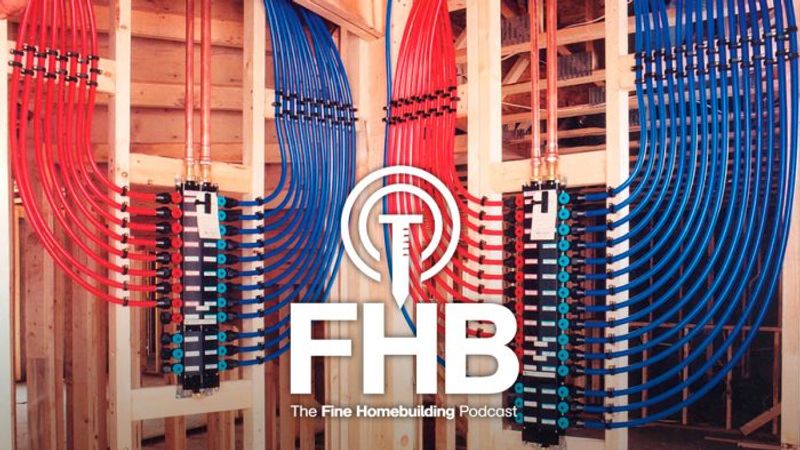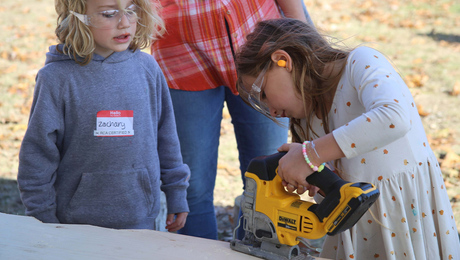Podcast 243: Minisplit Efficiency, Taking Down Chimneys, and Choosing Pex
Matt, Rob, and Patrick hear from listeners about fraudulent contractors and making a gazebo from a lightning-damaged tree, before taking questions about minisplits, pex plumbing, and weather-beaten housewrap.

Follow the Fine Homebuilding Podcast on your favorite app. Subscribe now and don’t miss an episode:
 |
 |
Jonathon reports on his year-long retaining wall saga. Barbara offers her insights on building a gazebo from a dead tree. Elizabeth asks why minisplits are more efficient than a ducted system. Andrew asks how to tell if a chimney is load-bearing. Nate wants to know which type of pex he should use and Paul needs a solution for his weather-beaten weather barrier.
Editor Updates:
Matt: Gardening, bathroom vanity cabinet
Jeff: Outdoor work
Rob: Gardening, porch stair framing
Patrick: Liam’s bedroom, gripes about my mediocre electrician
 |
 |
 |
 |
Listener Feedback 1:
Jonathan writes, Greetings. Way back in episode 143, you tackled my rotting retaining wall. It was two terraces in an L shape roughly 60 feet by 30 feet. We live on a steep slope that drops 90 feet to a creek; the wall is important for a useable backyard and erosion control.
 |
 |
 |
The initial quotes I got for replacement ranged from $17,000 to the $30,000. After expanding my search, I settled on an unlicensed contractor whose price was too good to be true. Our wives work together so what’s the worst that could go wrong? That was over a year ago. I think it’s important for your listeners to hear my lengthy cautionary tale.
The warning signs were there but his price had me looking past them. Two scathing reviews on Better Business Bureau should have told me everything I needed to know. He explained it away when I confronted him by saying “those clients were inpatients with the delays caused by rain.” Ok…Plausible.
He told me he was borrowing his wife’s car because his truck was “in the shop.” I later found out it was repossessed.
Once the job started he showed up once every couple weeks. I had to threaten him with court periodically just for him to show up for a couple hours. He’d show up with a dozens blocks and a couple bags of gravel from the home center. He should’ve ordered pallets of blocks and gravel by the truckload.
So how was his work? Funny you should ask.
He undermined a deck footing for our elevated deck, spread demolition debris over our yard instead of topsoil. He worked 18 days during over 11 months. He almost lost an excavator down the hill and left a rental truck mired in my yard.
The wall footing is only a couple inches of gravel. The drainage way improperly installed. It was too high in the wall and wasn’t protected from mud infiltration. No geogrid. He left a huge mess of logs on public land. He even tried to cheap out by using an inferior block to the one we agreed to in the contract.
In December 2019, the State of Maryland charged my contractor with various violations including acting as a home improvement contractor without a license, failure to complete a contract, theft/destruction of property. I was (willingly) subpoenaed as a witness for the State. The contractor pled guilty to the first charge and agreed to pay me restitution to avoid 6 months of jail time.
It may seem harsh but this guy was already on probation for operating as a contractor without a license. I learned just two weeks ago that the State charged him yet again for similar violations on another job. This will be his third time in court for the same offense. I’ll probably never see a penny. According to court records, he owes other clients…wait for it…$69,000! Some people never learn.
In March, I hired a reputable (and licensed!) company to finish the wall. He put rebar and concrete through some of the blocks. He reinstalled the drain correctly. Even so, he wouldn’t offer any warranty on the wall since he was finishing another person’s shoddy work.
I could go on for hours but I’ve already taken enough of your time. It’s been a long road. I’m happy to be through it.
I should have listened to my wife.
Related links:
Listener Feedback 2:
 Barbara writes: The tree that unlucky carpenter is tasked with outfitting with a gazebo is the absolute worst choice of a tree I could pick out of all the native North American trees. Here in the South we call that species basswood. It’s what they use to carve puppet heads. It’s very light and even grained. It is handy for woodworking, like a low-grade poplar, but not for anything structural. It’s what they sell at the craft store. It’s even terrible firewood. I did a wood density experiment and I used basswood as the example of not-dense wood. It’s on YouTube. Here it is queued up to the basswood part.
Barbara writes: The tree that unlucky carpenter is tasked with outfitting with a gazebo is the absolute worst choice of a tree I could pick out of all the native North American trees. Here in the South we call that species basswood. It’s what they use to carve puppet heads. It’s very light and even grained. It is handy for woodworking, like a low-grade poplar, but not for anything structural. It’s what they sell at the craft store. It’s even terrible firewood. I did a wood density experiment and I used basswood as the example of not-dense wood. It’s on YouTube. Here it is queued up to the basswood part.
That gazebo will be disgusting as the beetle larvae gobble up the cambium. Quickly they will turn the tree trunk into powder. Sawdust will rain down on the bench. Then the bark will fall off in chunks and centipedes and pillbugs and all kinds of ants will come cascading down. It might not get good fungus on the main trunk because of being covered, but the roots will happily rot away outside the drip zone and one day it will just tip over.
I think bark is really in fashion right now. But people have no concept of the function of bark. It’s a protective, expandable covering over a juicy layer of mostly sugar. Nature isn’t going to waste that! I get requests on Etsy to make stuff out of wood with bark on it. Like “log kitchen utensil holder big enough not to tip over with a ladle in it” or “beer stein for my boyfriend.” I quote them a price in the middle three figures including the process of soaking a freshly cut log in $60 worth of polyethylene glycol for a month to preserve the whole thing before milling out the inside on a lathe. So far nobody has asked me to go ahead with their special item. In fact they just never answer my email at all. I’m relieved by this because I don’t even own a lathe.
Related link:
Question 1: Are minisplits really more efficient than ducted HVAC systems?
Elizabeth writes, Hi FHB Crew, I appreciate you introducing me to ductless minisplits. One thing I don’t understand is how a ducted/standard hvac system with all ductwork in conditioned space is less energy efficient than ductless minisplits. I would love to hear your thoughts.
Related links:
- High-Performance HVAC
- When Ductless Minisplits Make Sense
- Heating a Tight, Well-Insulated House (greenbuildingadvisor.com)
Question 2: Are masonry chimneys ever load bearing?
Andrew writes, How can you tell if a chimney is load bearing? It runs through the center of the house and I would like to remove it. Keep up the great work, stay safe.
Related links:
Question 3: Which is best—PEX A, B, or C tubing?
Nate writes, Hello, I’m interested in changing my plumbing to pex. The previous homeowner made repairs to the homes original galvanized plumbing with: copper, cvpvc, and pex. I would really prefer the entire system be the same and intend on doing the work myself, with this in mind pex seems like the best option for me. Now for my question, which pex to use? I’ve done my research and this is what I’ve learned, pex A has leaching concerns, Pex B is stiff, and pex C is more sensitive to UV and cracking. Of course, there is more information available for each of the types, but with what I can find pex B seems like the lesser of the evils. Is this right? Which pex is most commonly used currently? Why does it seem like pex C is pushed harder (in more abundant suppy) at all my local home centers? Any help with this would be much appreciated.
Related links:
- PEX-Connection Fitting Systems – A Rundown
- Efficient Water Distribution with the Viega Manabloc Manifold
Question 4: How should I integrate new housewrap into existing window flashing?
Paul writes, Hello FHB Podcast folks, Thanks for the great podcast. I’ve learned a lot from listening to you guys.
I’m re-siding a building on my property and the Tyvek has now been exposed for over a year. Windows are all installed and I used DuPont FlexWrap to line the sills. How do I install a new layer of Tyvek without having reverse shingling under the windows? Thanks again for all the information you provide
Related links:
If you have any questions you would like us to dig into for a future show, shoot an email our way: [email protected].
If we use your question we’ll send you a FHB Podcast sticker!
 #KeepCraftAlive
#KeepCraftAlive
KeepCraftAlive hats help celebrate the value of true craftsmanship–plus 50% of all proceeds from every hat sold go to the #KeepCraftAlive Scholarship Fund, supported by Fine Homebuilding and SkillsUSA.
Buy a #KeepCraftAlive hat or t-shirt
This episode of the Fine Homebuilding podcast is brought to you by Danner.
If you believe in timeless ideas like quality, craftsmanship, and blazing your own path, I want to introduce you to our friends at Danner who sponsor this podcast. A Pacific Northwest original for over 85 years, Danner makes boots for people with purpose in their step. Boots like the new Steelyard family—featuring 8 different models with game-changing comfort, legendary durability, and performance features for any jobsite. Earn a pair and join the family at Danner.com.
Fine Homebuilding podcast listeners can now get 20% off anything in the Taunton store, including the Renovation 5th Edition.
Use the discount code FHBPODCAST to take advantage of this special offer.
We hope you will take advantage of a great offer for our podcast listeners: A special 20% off the discounted rate to subscribe to the Fine Homebuilding print magazine. That link goes to finehomebuilding.com/podoffer.
The show is driven by our listeners, so please subscribe and rate us on iTunes or Google Play, and if you have any questions you would like us to dig into for a future show, shoot an email our way: [email protected]. Also, be sure to follow Justin Fink and Fine Homebuilding on Instagram, and “like” the magazine on Facebook. Note that you can watch the show above, or on YouTube at the Fine Homebuilding YouTube Channel.
The Fine Homebuilding Podcast embodies Fine Homebuilding magazine’s commitment to the preservation of craftsmanship and the advancement of home performance in residential construction. The show is an informal but vigorous conversation about the techniques and principles that allow listeners to master their design and building challenges.
Other related links
-
- All FHB podcast show notes: FineHomebuilding.com/podcast.
- #KeepCraftAlive T-shirts and hats support scholarships for building trades students. So order some gear at KeepCraftAlive.org.
- The direct link to the online store is here.
























